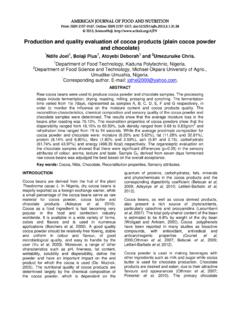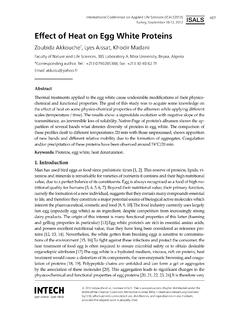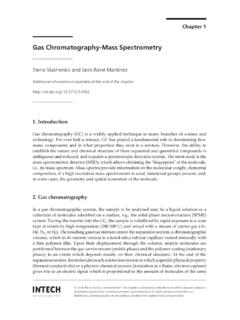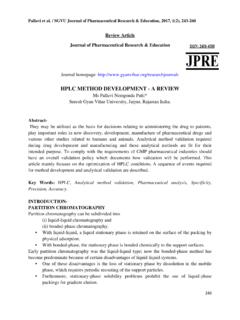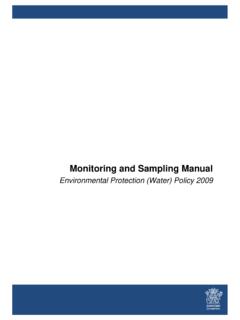Transcription of LABORATORY MANUAL ON SOIL AND PLANT ANALYSIS …
1 Organized byDepartment of Soil Science & Agricultural ChemistryJawaharlal Nehru Krishi Vishwa Vidyalaya, Jabalpur 482 004 ( )Centre of Advanced Faculty TrainingNATIONAL TRAININGONLABORATORY MANUAL ONSOIL AND PLANT ANALYSISC limate Resilient Soil Management Strategiesfor Sustainable Mitra14 October to 3 November, 2015thrd"Healthy Soils for a Healthy Life"CitationPublished byCompiled and Edited byPrinted at LABORATORY MANUAL on Soil and PLANT ANALYSIS . 2015 (pp 50)National Training on Climate Resilient Soil Management Strategies forSustainable AgricultureCentre of Advanced Faculty TrainingDepartment of Soil Science and Agricultural ChemistryJawaharlal Nehru Krishi Vishwa Vidyalaya, Jabalpur 482 004 ( )held during - 14 October to 3 November, 20152015, Jawaharlal Nehru Krishi Vishwa Vidyalaya, Jabalpur 482004 ( ), IndiaDirectorthrdCentre of Advanced Faculty TrainingDepartment of Soil Science & Agricultural ChemistryJawaharlal Nehru Krishi Vishwa VidyalayaJabalpur 482 004 ( ), IndiaDr.
2 DwivediDr. SharmaMr. AmuleMr. TagoreDr. DwivediDr. MitraFortune Graphics & Scanning CentreJabalpur 482 002 ( ), Ph.: 0761-4069025 LABORATORY MANUAL on Soil and PLANT ANALYSIS National Training on Climate Resilient Soil Management Strategies for Sustainable Agriculture (14th October to 3rd November, 2015) B. S. Dwivedi Sharma Amule Tagore Dwivedi Mitra Sponsored by Indian Council of Agricultural Research Organized by Centre of Advanced Faculty Training Department of Soil Science and Agricultural Chemistry Jawaharlal Nehru Krishi Vishwavidyalaya Jabalpur 482004 ( ) I N D E X Title Page No. 1. Method of Collection of Soil and PLANT samples for Their Testing 1-4 2. Profile Studies of Deep Black Soils (Vertisols) 5-8 3. Creation of spatial variability maps of soil nutrient using geo-statistical tool 9-10 4. Determination of pH and Electrical Conductivity in Soil samples 11-12 5.
3 Determination of Organic Carbon Content in Soil 13 6. Determination of Available Nitrogen in Soil 14-15 7. Determination of Total Nitrogen in Soil and PLANT samples 16-17 8. Determination of Phosphorous in Soil and PLANT samples 18-19 9. Determination of Potassium in Soil and PLANT samples 20-21 10. Determination of Sulphur Content in Soil and PLANT 22-23 11. Determination of Micronutrients in Soil and PLANT samples by Atomic Absorption Spectrophotometer 24-26 12. Estimation of Boron in Soils, Plants and water 27-28 13. Estimation of Microbial Biomass Carbon in Soil 29 14. Gamma Irradiation and its Importance for Food Preservation 30-34 15. Determination of Soil Aggregates 35-36 16. Determination of Bulk Density of Soil by Core Method 37 17. Estimation of Ascorbic Acid in Vegetables and Fruits 38 18. Estimation of Chlorophylls in Vegetables and Fruits 39 19.
4 Estimation of Total Carotenoids in Vegetables and Fruits 40 20. Definitions 41 21. Preparation of Glassware 42 22. Appendix I to VI 43-50 Climate Resilient Soil Management Strategies for Sustainable Agriculture from14th October to 3rd November, 2015 Jawaharlal Nehru Krishi Vishwa Vidyalaya, Jabalpur 482004 ( ) Healthy Soils for a Healthy Life 1 Method of Collection of Soil and PLANT samples for Their Testing Dwivedi Department of Soil Science and Agricultural Chemistry College of Agriculture, , Jabalpur The information obtained from PLANT and soil testing which reflect soil and PLANT health respectively is used for the exploitation of soil and potential for obtaining maximum yield. Assessment of a soils fertility status involves an estimation of its available nutrient status the portion or amount of nutrient directly available in soil for subsequent uptake by crop PLANT .
5 The causes of success or failure of this testing are varied usually related to the quality and amount of research data available for calibration, interpretation and recommendations. With reference to this, testing refers to any physical or chemical measurement made on soil/ PLANT . The meaning may be restricted in the sense that it implies rapid chemical ANALYSIS used to assess the (available) nutrient status of soil/ PLANT or the meaning may be broader due to use in evaluation interpretation and recommendations. Acceptance of this testing is strongly dependent upon the accuracy with which these tests can be used in solving the localized problems related to crop response and fertilizer use. Nutrient status of soil and PLANT acts as a barometer of their health.
6 This can be evaluated in several different ways each having its pros and cons. But the accepted methods include soil testing and PLANT testing. Why soil testing ? Soils fertility status assessment involves an estimation of its available nutrient status It gives the amount of nutrient directly available in soil for subsequent uptake by crop PLANT . Guides to arrive at optimum fertilizer application ratio. It is a method of evaluating nutrient status (physico-chemical properties) of the soil the assessment of the fertility of the soil to determine nutrient deficiencies. It is also concerned with environmental quality for the community hazards. Objectives (i) To evaluate soil fertility and its productivity by the estimation of level of nutrient (Low, Medium, High).
7 (ii) Grouping of soil for their classification (iii) To determine the specific soil problem such as an acidity, alkalinity and sodicity if exist. Subsequently giving recommendation for their correction (Lime/Gypsum requirement etc.) (iv) To predict the probability of getting maximum response of crops to fertilizers. Objectives of soil testing: To study/ maintain fertility status of a field. To predict the probability of obtaining a profitable response of lime & fertilizers. To provide basis for recommendation of fertilizers. Toevaluatefertilitystatusofsoilofanarea/ state/countryfordevelopedofplansforresea rchandeducationwork. To study the acidity, alkalinity and salinity problems. To determine the suitability of the soil for laying gardens. Lime problems. Soil survey.
8 Apparatus and materials: Khurpi Spade Augers Plastic bowl Scale Rack Wooden roller Mortar-pestle Sieve Polythene/paper/cloth bags Labels Card board cartons Aluminium boxes Screw Auger Tube Auger Climate Resilient Soil Management Strategies for Sustainable Agriculture from14th October to 3rd November, 2015 Jawaharlal Nehru Krishi Vishwa Vidyalaya, Jabalpur 482004 ( ) Healthy Soils for a Healthy Life 2 To meet objective of soil testing is divided into 4 phases: 1. Collection of soil samples 2. Extraction and determination of the available nutrients 3. Interpretation of analytical results 4. Providing recommendation 5. Follow up of results and evaluation of the recommendations made Procedure for soil testing The procedure for testing the soil to meet these objectives are divided into the following phases: (i) Collection of soil samples and its preparation (ii) Extraction and determination of nutrients and physico-chemical properties of the soil.
9 (iii) Interpretation of analytical results (iv) Recommendation and follow up of results and evaluation of recommendations. Collection of soil samples Since soil is a very heterogeneous mass and the greatest source of error is usually soil samples itself hence, the soil sample collected should be representative of the area sampled and should also be uniform. Variations in slope, texture, colour, crops grown, and management levels must be taken in to account. Recently fertilized plot, bunds and channel, spot near tree, wells, compost pits and other non-representative locations must be avoided while sampling. When crops are planted in rows, samples can be drawn in between the lines. The sample should be taken in a zig-zag manner. A representative composite soil samples can be composed of 8 to 20 sub samples from a uniform field (Jones 1988).
10 A common error in soil sampling occurs when the top few cm of soil are dry and are not included in the normal sample. Hence, the value of soil test depends on how well the sample represents a field. A variety of factors such as depth of sampling, number of cores of composite sample, season, crop etc. influence the collection of soil samples . For field crops a sampling depth upto 15-30 is desired while, 10 cm depth is normally sufficient for sampling for the pasture crops (Rao, 1995). For deep rooted crops, horticultural crops or under dry farming conditions sample from various depths may be preferred. For immobile nutrient, testing of sample to tillage depth may give satisfactory results but for testing of mobile nutrients (NO+3-, Cl-, SO4-- etc.)
